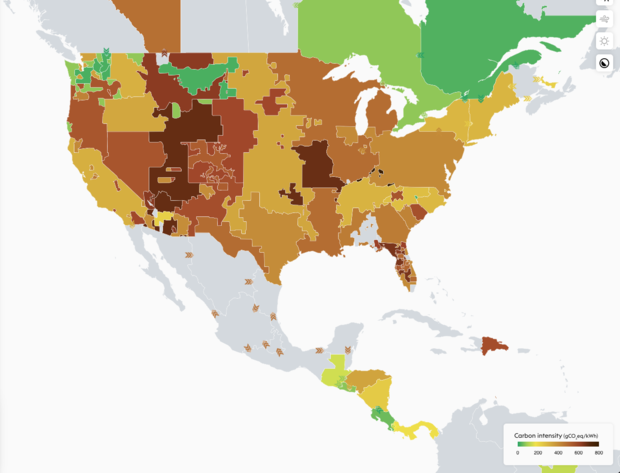Electric vehicles are essential in limiting global warming. Experts say they need a clean power grid to maximize their potential.
Electric vehicles are growing in political popularity, with President Biden's signing of the Inflation Reduction Act that invests $400 billion in energy security and fighting climate change and California's push to eliminate new sales of gas-powered cars. Just a simple switch to electric vehicles is crucial and significant in limiting fossil fuels and global warming, but without a clean power grid to back them up, they can't reach their full planet-saving potential.
Sam Houston, a senior vehicles analyst for the clean transportation program at the Union of Concerned Scientists, told CBS News just how effective EVs can be.
Passenger vehicles are one of the biggest sources of global warming emissions in the U.S., according to a July report from the Union of Concerned Scientists. The group's analysis found that over the lifetime of an electric car – from the time it's manufactured to when it's disposed of – it will produce roughly half the global warming pollution than a comparable gas- or diesel-powered vehicle.
The group's online vehicle emissions comparison tool shows, for example, that if someone used a 2022 Toyota RAV4 plug-in hybrid car in central Tampa, Florida, they would get 52 miles per gallon carbon dioxide equivalent — known as MPG-CO2e — compared with the national average of 22. The higher a vehicle's MPG-CO2e, the less it contributes to global warming pollution.
But how much less they contribute to global warming pollution depends on where they get their power.
"It's super important to keep working on the progress of cleaning the grid as we adopt electric vehicles," Houston said. "...There's no shortage of examples of climate change-exacerbated events, whether it's heat waves, fires, flooding, hurricanes. The more we can do, the sooner we do it, it's going to help alleviate those things, or at least not let them get any worse."
In 2021, renewable energy sources account for 12.2% of the country's energy consumption and just over 20% of electricity generation. Fossil fuels, primarily natural gas and coal, made up nearly 61% of electricity generation, according to the U.S. Energy Information Administration.
And while 94% of the transportation sector relied on petroleum and natural gas, just 5% of the energy consumed in the sector was sourced by renewable energy — and less than 1% came from electricity retail sales, according to the EIA. All of the renewable energy consumed in the transportation sector came from biofuels.
A closer look at the electricity sector shows that 59% of its sourcing came from petroleum, natural gas and coal, while 41% came from nuclear and renewable energy.
The more transportation is electrified, the more power is going to be added and needed throughout the nation, Lori Bird, director of the World Resource Institute's U.S. Energy program, told CBS News.
"We need to do that in a way that we don't stress the grid too much," she said. "...It does matter how clean the grid is."
But what kind of energy people use depends on where they live.
The U.S. installed record numbers of wind turbines and solar capacity in 2020 and 2021, she said, but the country needs to double those levels in the coming years and then "perhaps triple after that."
Electricity Maps created a map showing in real-time the carbon intensity of various regions. In the U.S, western parts of the country tend to have more carbon-intense energy production from their local utility sources, while the northeast is significantly lower. Very few pockets of the U.S., mostly small areas in Washington state, have extremely low carbon intensity.
The more renewable energy that's used, the less carbon dioxide it takes to provide power and the less greenhouse gas emissions are put into the atmosphere.
"Renewable energy sources, such as wind, hydro or solar power, produce next to no CO2 emissions, so their carbon intensity value is much lower and often zero," according to London-based utility company National Grid. "Using electricity with a low carbon intensity value will reduce carbon emissions overall — especially if we use it during times when the largest amounts of clean electricity are being generated."
Houston said the Inflation Reduction Act is "a step in the right direction" to address these problems and help curb the worst effects of climate change. Along with new incentives and tax credits to help consumers purchase electric vehicles, it also invests billions in tax credits to speed up solar panel and wind turbine production as well as to build clean technology manufacturing facilities.
The more renewable energy the nation uses, the cleaner the grid will get and the more effective electric vehicles will be.
And this transition to a cleaner grid and more electric vehicles isn't just good for the planet, it's economically beneficial, both Bird and Houston told CBS News.
Solar and wind energy are already "very cost-effective" generation sources, according to Bird. And they, combined with electric vehicles, will also be money-saving for consumers. Unlike natural gas, the cost of solar and wind isn't as unstable because they rely on sunlight and wind rather than the availability of fossil fuels, which could make home energy consumption cheaper, even when considering having to charge an electric car.
Bird said for her to charge her electric vehicle at home, it's about half the cost of gasoline, though she said the specifics will depend on the cost of gas and type of vehicle.
"Generally, it can be significant savings," she said.
The price of buying electric vehicles has also gone down over the years and will be even lower with the nation's new incentives. Maintenance costs also tend to be lower with EVs, Bird said.
Houston said that overall, she's encouraged by the policies that have been pushed through. They're not perfect by any means she said, but they have everyone "feeling more optimistic."
"We're really changing the dynamic of how the grid and the transportation system interacts," she said. "...It's just an exciting trajectory to see and we just hope that it can accelerate ... There's always more to do, but every step in the right direction really matters."






